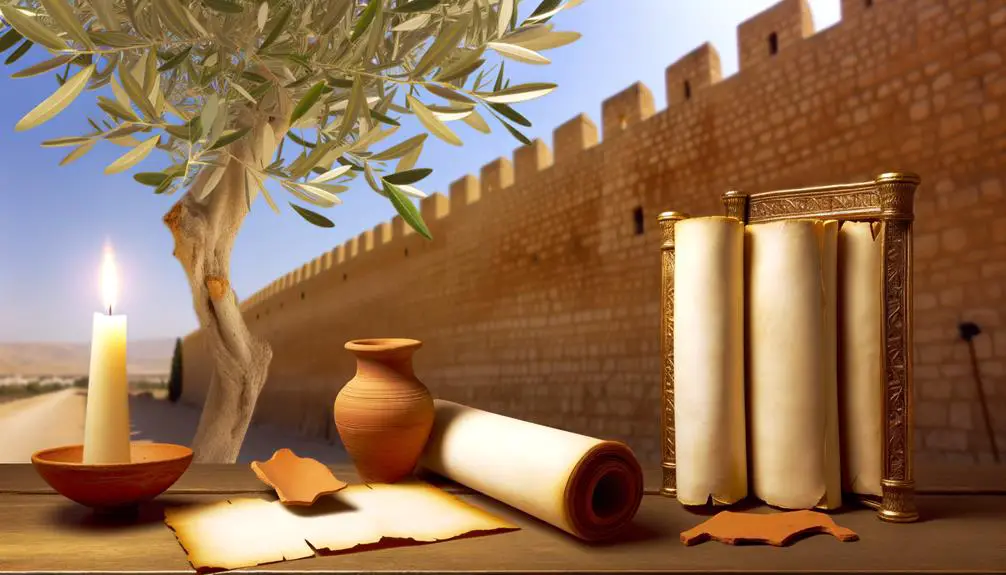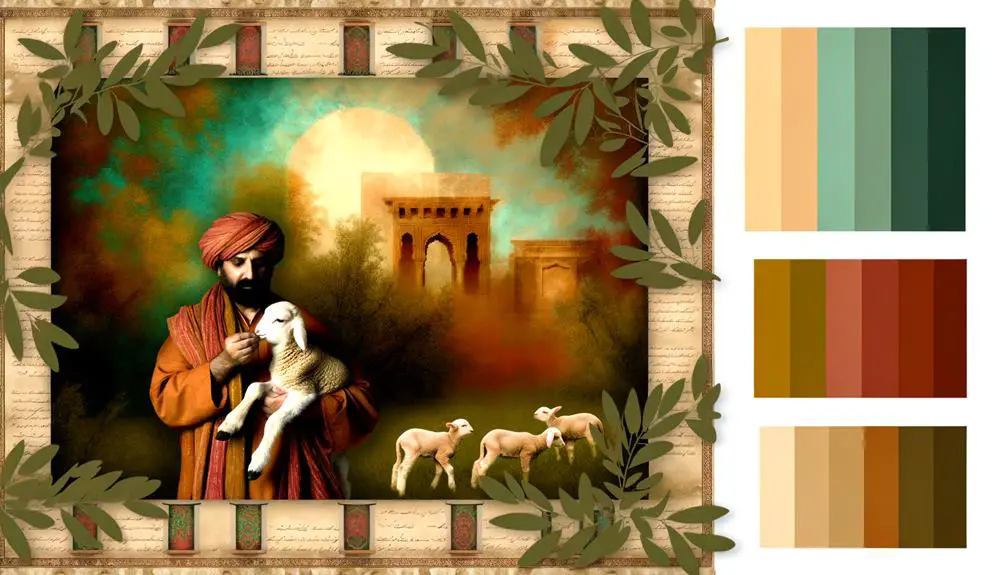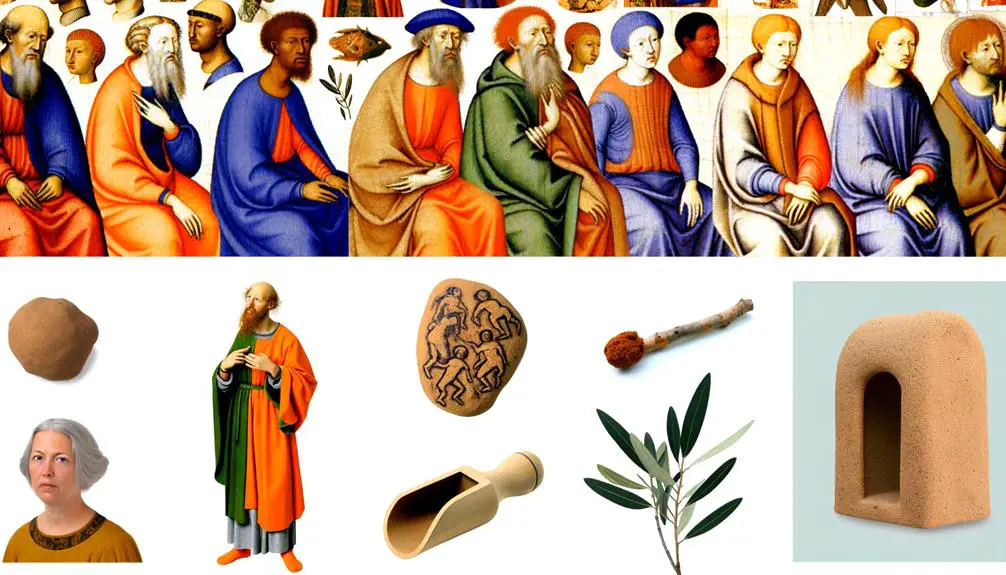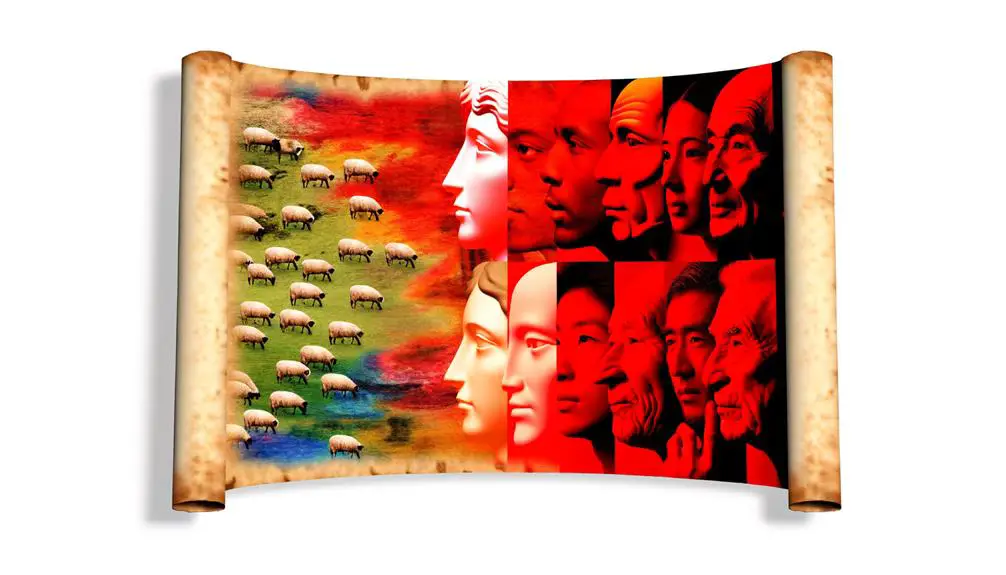Discover the nuanced meaning of 'ruddy' in biblical texts and its impact on character portrayal—dive deeper to unravel its cultural significance.

What Does Ruddy Mean in the Bible
Navigating the biblical landscape, you'll find the term 'ruddy' as a brushstroke that colors characters in a light of health and beauty. Historically, this descriptor has painted figures like David with an aura of vitality, but its hues vary when viewed through the lens of different cultures and epochs.
As you explore this term's journey from its ancient roots to its place in modern interpretations, you'll uncover layers of meaning that extend beyond the surface. Unraveling these threads promises to enrich your understanding of biblical imagery and its evolving significance.
Key Takeaways
- Ruddy signifies health, vitality, and divine favor in biblical contexts.
- Descriptions of ruddy complexions reflect ancient values of beauty and strength.
- Characters marked as ruddy are often associated with purity of heart and destiny.
- Understanding ruddy enriches modern interpretations of biblical narratives and character analysis.
Definition of Ruddy

In its most fundamental sense, 'ruddy' refers to a distinctive reddish complexion, often symbolizing health, vitality, or youth in biblical contexts. You'll find that this term isn't just a broad brushstroke of color but delves into the nuanced palette of human skin tones, reflecting a range of color variations inherent to the human condition.
Analytically speaking, the term 'ruddy' in biblical passages isn't a one-size-fits-all descriptor. It encompasses a spectrum of skin tones from light pinkish hues to deeper reddish-brown shades. This diversity in description allows for a more inclusive understanding of biblical characters, acknowledging the variety of human complexions within ancient narratives.
Moreover, the term's usage underscores a cultural appreciation for health and vigor, as represented by the color's warmth and richness. The ruddy complexion is often indicative of a life lived outdoors, basking in the natural elements, which, in ancient times, was synonymous with a robust and hearty existence. Thus, 'ruddy' in scriptural texts does more than just describe physical appearance; it conveys a deeper, symbolic resonance of vitality and youthfulness, attributes highly prized in biblical times.
To dissect 'ruddy' further, it's vital to recognize the term's adaptability across different contexts within the Bible. Depending on the passage, 'ruddy' might highlight an individual's youthful beauty or, alternatively, their physical strength and readiness for battle. This adaptability showcases the term's layered significance, enriching our understanding of biblical narratives through the lens of color variations and skin tones.
Historical Context

Delving into historical contexts, it's crucial to understand that the term 'ruddy' reflects more than mere complexion; it encapsulates societal values and environmental influences prevalent during biblical times. This term, often used to describe a healthy, vibrant appearance, carries with it a wealth of historical significance that stretches beyond the surface level.
- Geographical Influences: The geographical setting of the biblical narratives played a substantial role in shaping the physical characteristics deemed desirable or noteworthy. In the arid, sun-drenched landscapes of the Near East, a ruddy complexion could indicate a life of outdoor labor and health, contrasting with the paler skin associated with indoor confinement and aristocracy.
- Societal Values: In biblical times, societal values were closely tied to physical appearance. A ruddy complexion was often seen as a sign of vitality, vigor, and divine favor. This physical attribute was emblematic of the idealized warrior or shepherd, braving the elements and embodying the virtues of strength and resilience.
- Cultural Dress: The cultural dress of the era also played a part in highlighting or downplaying the ruddy complexion. Light, airy garments typical of the region's attire would allow the sun to kiss the skin, further accentuating a healthy glow that was prized and often associated with godly favor or royal lineage.
- Environmental Influences: Lastly, the environmental conditions, including exposure to the harsh sun and wind, contributed to the development of a ruddy appearance among the populace. This wasn't merely a sign of health but also a marker of one's ability to endure and thrive in challenging conditions.
Understanding the term 'ruddy' within these historical contexts reveals its complexity, reflecting a deep interplay of geographical, societal, and environmental factors that shaped the biblical world's perceptions of beauty and worth.
Biblical Passages Mentioning Ruddy

Several biblical passages feature the term 'ruddy' to describe characters, notably highlighting their vitality and attractiveness within the narrative's cultural and physical context. This term, often associated with a healthy, vibrant complexion, reveals much about ancient cultural perceptions and the significance placed on physical appearance.
In the case of David, the shepherd boy who'd become king, the Bible specifically mentions his ruddy appearance as part of his introduction to Saul and the reader (1 Samuel 16:12). This description not only sets David apart in the narrative but also aligns with the cultural ideal of beauty and health at the time. David's ruddy complexion contrasts with the prevailing color variations of his peers, marking him as God's chosen one due to his distinct physical attributes.
Similarly, the Song of Solomon makes use of 'ruddy' to describe the beloved's physical charm (Song of Solomon 5:10). This poetic usage underscores the appeal of a ruddy complexion in the context of romantic and physical attraction, further embedding the term within the cultural fabric of beauty and desirability.
The application of 'ruddy' across these passages provides insight into the ancient world's aesthetics, where color variations in skin tone carried implications of health, vigor, and divine favor. It also illustrates how the Bible uses physical descriptions to deepen character development and thematic resonance. Through these mentions, you're invited to consider how cultural perceptions of beauty and health are intricately woven into the biblical narrative, offering a richer understanding of its characters and their contexts.
Symbolism and Significance

You'll find that the term 'ruddy' carries profound symbolic weight within the biblical context, particularly when analyzing its divine implications and interpretations related to physical appearance.
This hue not only signifies health and vitality but also serves as a marker of divine favor or selection among Biblical figures.
Consequently, understanding these nuances offers deeper insights into the characterizations and thematic elements woven throughout the scriptures.
Ruddy's Divine Implications
Why does the term 'ruddy' carry profound divine implications in biblical texts? The keyword 'ruddy' isn't just a mere descriptor of physical appearance; it's laden with rich, symbolic meanings that resonate deeply within the theological and cultural context of the Bible. It's a term that goes beyond the surface, hinting at a deeper, divine narrative.
- Health Connotations: 'Ruddy' signifies robust health and vitality, suggesting a life blessed by divine providence.
- Divine Favor: Individuals described as 'ruddy' are often marked by God's favor, indicating a special role or mission.
- Symbol of Purity: The color's natural association implies purity and simplicity of heart, favored by the divine.
- Indicator of Potential: Being 'ruddy' symbolizes latent potential and destiny, as recognized by divine forces.
Physical Appearance Interpretations
Delving into the symbolism and significance of physical appearance in biblical texts, the term 'ruddy' emerges as a multi-faceted symbol, reflecting not only societal ideals but also divine selection and favor. This term isn't just about the physical; it intertwines with ancient skin care practices and fashion styles, showcasing a preference for a vibrant, healthy appearance that signified divine blessing and societal preference.
Aspect |
Symbolism |
Emotion |
|---|---|---|
Ruddy Complexion |
Divine Favor |
Awe and Respect |
Skin Care |
Ritual Purity |
Serenity |
Fashion Styles |
Societal Status |
Admiration |
You're invited to see through this lens, understanding that beyond the surface, these descriptions offer deep insights into the values and aspirations of ancient societies.
Ruddy in Ancient Art

Often, ancient art depicts individuals with a ruddy complexion, reflecting cultural and historical perceptions of beauty and health. This portrayal isn't arbitrary but carries deep meanings related to color symbolism and the societal values of the time. As you delve into the significance of ruddy complexions in these artistic depictions, it's crucial to understand the nuanced ways in which color was employed to convey messages about identity, virtue, and social status.
Here are four key points to consider:
- Color Symbolism: In many cultures, a ruddy complexion was symbolic of vitality and vigor. This color symbolism is evident in various forms of ancient art, where individuals of high esteem, including warriors and heroes, are often depicted with a healthy, reddish hue to their skin.
- Artistic Depictions: Artists used pigments and techniques that highlighted the ruddy complexions of figures to emphasize their strength and desirability. This wasn't merely a matter of aesthetics but a deliberate choice to align with cultural values and narratives.
- Cultural Significance: The preference for ruddiness in ancient art reflects broader societal attitudes towards health, beauty, and status. A ruddy appearance was associated with outdoor labor and physical fitness, traits valued in many ancient societies.
- Material and Method: The materials and methods used to achieve the ruddy effect in ancient art deserve attention. Artists often mixed ochres and reds in innovative ways, applying them to convey not just the physical but the moral and spiritual qualities of their subjects.
Through this lens, the ruddy complexions seen in ancient art serve as a window into the values and aspirations of past cultures, illustrating how deeply color symbolism and artistic depictions were intertwined with notions of identity and esteem.
Interpretations Over Time

You've observed how 'ruddy' was depicted in ancient art.
But it's essential to explore how interpretations have shifted over time due to historical contextual changes and the evolution of linguistic meanings.
These shifts offer a window into the complex ways societies have understood and articulated physical descriptions in the Bible.
Historical Contextual Shifts
How has the interpretation of 'ruddy' in biblical texts shifted over historical contexts, reflecting broader changes in linguistic and cultural understandings? This question opens a detailed exploration into how cultural perceptions and geographical variations have influenced the understanding of 'ruddy' through the ages.
- Cultural Perceptions: Initially, 'ruddy' might've denoted health and vitality, nuanced by cultural ideals of beauty and strength prevalent at the time.
- Geographical Variations: The term's interpretation has varied significantly across different regions, influenced by local climates and racial demographics.
- Scholarly Reinterpretations: Academic studies have revisited ancient texts, offering new insights based on archaeological finds and historical records.
- Technological Advancements: Modern technology, including linguistic software, has allowed for a more nuanced analysis of the term's usage and evolution over time.
Evolving Linguistic Meanings
Throughout history, the interpretation of 'ruddy' in biblical texts has undergone significant shifts, reflecting broader linguistic and cultural evolutions. Language evolution and semantic drift are pivotal in understanding these transformations. You'll notice that words don't just change; they evolve in response to societal changes, scholarly interpretations, and linguistic trends.
Era |
Interpretation |
Influence |
|---|---|---|
Ancient |
Healthy glow |
Contextual clues |
Medieval |
Warrior-like |
Cultural values |
Renaissance |
Artistic, ideal beauty |
Aesthetic standards |
Modern |
Ambiguity, diverse meanings |
Scholarly debate |
Contemporary |
Re-examination, inclusivity |
Social awareness |
This table shows how 'ruddy' has morphed, influenced by various factors over time. It's a testament to the fluid nature of language, urging you to appreciate the complexity behind a seemingly simple term.
Implications for Modern Readers

For modern readers, understanding the biblical use of 'ruddy' can illuminate subtle nuances in character descriptions that are often overlooked. This exploration into the term's significance not only enriches your comprehension of biblical narratives but also challenges contemporary color perceptions, urging a reevaluation of how physical attributes are depicted and interpreted. The contemporary relevance of such a linguistic investigation extends beyond mere academic curiosity, offering insights into the cultural and historical contexts that have shaped these texts.
Analyzing the implications for modern readers involves considering several key aspects:
- Cultural Interpretation: Recognizing how cultural differences in color perception can affect the understanding of biblical characters and their attributes. This awareness promotes a more nuanced reading of the texts.
- Historical Context: Understanding the historical significance of the term 'ruddy' helps in appreciating the physical ideals and attributes valued by ancient societies, thereby offering a window into their worldviews.
- Literary Analysis: Examining the use of 'ruddy' in a literary context highlights the artistic methods employed by biblical authors to convey character virtues, health, and divinely favored status through physical descriptions.
- Theological Implications: Considering the theological ramifications of physical descriptions in the Bible can lead to a deeper understanding of how humanity is portrayed in relation to divinity, emphasizing the inherent worth and dignity of all individuals regardless of physical characteristics.
Frequently Asked Questions
How Does the Interpretation of "Ruddy" Compare Between Different Translations of the Bible, Such as the King James Version Versus the New International Version?
When you compare 'ruddy' between the King James Version and the New International Version, you'll notice differences in translation consistency, especially regarding color symbolism.
The King James often retains older, more literal translations, suggesting a healthy, reddish complexion.
In contrast, the New International Version might lean towards interpretations fitting contemporary language, focusing less on specific color connotations.
This variance underscores the importance of context in understanding biblical descriptions and their symbolic meanings.
Are There Any Notable Figures Outside of the Bible Who Were Described as Ruddy, and How Did That Description Influence Their Historical or Mythical Portrayal?
Diving into history's canvas, you'll find figures painted with the brush of 'ruddy' beyond biblical texts. This description isn't just a color; it's a window into historical accuracy and mythological symbolism.
For instance, ancient warriors and kings were often depicted as ruddy, symbolizing vigor and health. This portrayal wasn't arbitrary but reflected societal ideals and attributes admired in leaders, weaving a rich tapestry of how appearance influenced perception and legacy.
How Has the Depiction of Ruddy Individuals in Renaissance Art Influenced Modern Perceptions of Biblical Characters?
Renaissance artists, embracing artistic license, often depicted biblical characters with ruddy complexions, embedding deep color symbolism into their works.
You'll notice this choice has shaped modern perceptions significantly. By portraying these figures with a healthy, vibrant glow, artists not only highlighted their heroism and divine favor but also influenced how you perceive biblical narratives today.
This artistic interpretation, rich in symbolism, continues to shape your understanding of these characters and their stories.
In What Ways Have Linguistic Studies Challenged or Supported the Traditional Interpretations of the Term "Ruddy" in Biblical Contexts?
You're barking up the right tree if you're curious about how linguistic studies have either debunked or upheld traditional views of 'ruddy' in biblical texts.
These studies delve deep into color semantics and cultural perceptions, shedding light on the nuances of ancient language.
They scrutinize how 'ruddy' has been interpreted across different cultures and epochs, offering a scholarly, detailed analysis that challenges or confirms long-held beliefs about this biblically significant term.
Can the Description of Someone as "Ruddy" in the Bible Inform Us About the Health and Nutrition Standards of Ancient Societies Mentioned in the Scriptures?
When you delve into the description of someone as 'ruddy,' you're uncovering layers about skin color significance and dietary implications in ancient societies. This term hints at more than just a physical trait; it's a window into the health and nutrition standards of the time.
Conclusion
In summary, you've delved into the multifaceted significance of 'ruddy' in biblical texts, uncovering its roots in historical and cultural contexts. By examining its appearances and symbolic weight across scripture, alongside its depiction in ancient art and evolving interpretations, you've gained a richer understanding of its implications.
This exploration not only sheds light on ancient narratives but also speaks volumes to modern readers, proving that old wine in new bottles can indeed offer fresh insights into timeless themes.



Sign up